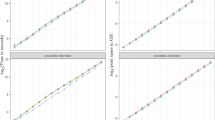Abstract
Gene and protein sequence analyses, central components of studies in modern biology are easily amenable to string matching and pattern recognition algorithms. The growing need of analysing whole genome sequences more efficiently and thoroughly, has led to the emergence of new computational methods. Suffix trees and suffix arrays are data structures, well known in many other areas and are highly suited for sequence analysis too. Here we report an improvement to the design of construction of suffix arrays. Enhancement in versatility and scalability, enabled by this approach, is demonstrated through the use of real-life examples.
The scalability of the algorithm to whole genomes renders it suitable to address many biologically interesting problems. One example is the evolutionary insight gained by analysing unigrams, bi-grams and higher n-grams, indicating that the genetic code has a direct influence on the overall composition of the genome. Further, different proteomes have been analysed for the coverage of the possible peptide space, which indicate that as much as a quarter of the total space at the tetra-peptide level is left un-sampled in prokaryotic organisms, although almost all tri-peptides can be seen in one protein or another in a proteome. Besides, distinct patterns begin to emerge for the counts of particular tetra and higher peptides, indicative of a ‘meaning’ for tetra and higher n-grams.
The toolkit has also been used to demonstrate the usefulness of identifying repeats in whole proteomes efficiently. As an example, 16 members of one COG, coded by the genome of Mycobacterium tuberculosis H37Rv have been found to contain a repeating sequence of 300 amino acids.
Similar content being viewed by others
References
Abouelhoda M I, Kurtz S and Ohlebusch E 2002 The enhanced suffix array and its applications to genome analysis; Proceedings of the Second Workshop on Algorithms in Bioinformatics, September 17–21 (Springer-Verlag) pp 449–463
Arimura J, Asaka H, Sakamoto H, Arikawa S 2001 Efficient discovery of proximity patterns using suffix arrays; July 1–4, Jerusalem, Israel
Bejerano G and Yona G 2001 Variations on probabilistic suffix trees: statistical modeling and prediction of protein families; Bioinformatics 17 23–43
Beuhler E C and Ungar L H 2001 Maximum entropy methods for biological sequence modeling; in Workshop on Data Mining in Bioinformatics 2001 (BIOKDD 2001) pp 60–64
Bieganski P, Riedl J, Carlis J Retzel E F 1994 Generalized Suffix Trees for Biological Sequence Data. 1994 System Sciences V: Biotechnology Computing; in Proceedings of the Twenty-Seventh Hawaii International Conference, University of Minnesota, vol 5, pp 35–44
Brosch R, Pym A S, Gordon S V and Cole S T 2001 The evolution of mycobacterial pathogenicity: clues from comparative genomics; Trends Microbiol. 9 452–458
Burkhardt S, Crauser A, Ferragina P, Lenhof H-P, Rivals E, et al 1999 q-gram based database searching using a suffix array (QUASAR); in RECOMB, Annual Conference on Research in Computational Molecular Biology, Proceedings, Lyon, France, pp 77–83
Caporale L H 1999 Chance favors the prepared genome; Ann N. Y. Acad. Sci. 870 1–21
Cole S T, Brosch R, Parkhill J, Garnier T, Churcher C et al 1998 Deciphering the biology of Mycobacterium tuberculosis from the complete genome sequence; Nature (London) 393 537–544
Cole S T, Eiglmeier K, Parkhill J, James K D, Thomson N R et al 2001 Massive gene decay in the leprosy bacillus; Nature (London) 409 1007–1011
Delcher A L, Kasif S, Fleischmann R D, Peterson J, White O et al 1999 Alignment of whole genomes; Nucleic Acids Res. 27 2369–2376
Fang Z, Doig C, Morrison N, Watt B and Forbes K J 1999 Characterization of IS1547, a new member of the IS900 family in the Mycobacterium tuberculosis complex, and its association with IS6110; J. Bacteriol. 181 1021–1024
Ganapathiraju M, Klein-Seetharaman J, Balakrishnan N and Reddy R 2004a Characterization of protein secondary structure using latent semantic analysis. IEEE Signal Processing magazine, May 2004, issue 15, 78–87
Ganapathiraju M, Manoharan V and Klein-Seetharaman J 2004b BLMT: Statistical Sequence Analysis using N-grams; J. Appl. Bioinformatics 3 193–200
Ganapathiraju M, Weisser D, Klein-Seetharaman J and Reddy R 2004c Yule value tables from protein datasets of different categories: emphasis on trasnmembrane proteins; Proc. SCI2004, Florida, USA
Ganapathiraju M, Weisser D, Rosenfeld R, Carbonell J and Reddy R et al 2002 Comparative n-gram analysis of whole-genome sequences; HLT’02: Human Language Technologies Conference, San Diego, March, 2002. San Diego, USA
Gardner M J, Hall N, Fung E, White O, Berriman M et al 2002 Genome sequence of the human malaria parasite Plasmodium falciparum; Nature (London) 419 498–511
Gusfield D 1997 Algorithms on strings, trees and sequences (Cambridge University Press)
Hunt E, Irving R W and Atkinson M 2000 Persistent Suffix Trees and Suffix Binary Search Trees as DNA Sequence Indexes. Glasgow: Department of Computing Science, University of Glasgow. TR-2000-63
Irving R W and Love L 2001 suffix binary search trees and suffix arrays. Dept of Computing Science, University of Glasgow. TR-2001-82
Kasai T, Lee G, Arimura H, Arikawa S, Park K. 2001 Linear-Time Longest-Common-Prefix computation in Suffix Arrays and Its applications; Lecture Notes in Computer Science, Combinatorial Pattern Matching: 12th Annual Symposium, CPM 2001, July 1–4, Israel, Proceedings, 181–192
Klein-Seetharaman J, Ganapathiraju M, Rosenfeld R, Carbonell J and Reddy R 2002 Rare and frequent amino acid n-grams in whole-genome protein sequences; 2002; RECOMB’02: The Sixth Annual International Conference on Research in Computational Molecular Biology, Washington DC, USA
Malde K, Coward E and Jonassen I 2003 Fast sequence clustering using a suffix array algorithm; Bioinformatics 19 1221–1226
Manoharan V, Ganapathiraju M and Klein-Seetharaman J 2006 Ambient Intelligence Everyday Life; in Lecture notes in computer science (eds) Y Cai, J Abascal, (Springer) (in press)
Puglisi, S J, Smyth, W F and Turpin, A H 2007 A taxonomy of suffix array construction algorithms; ACM Comput. Surv. 39, 2, Article 4, June
Rosenfeld R 1997 CMU Cambridge statistical language modeling toolkit (Proceedings ESCA Eurospeech)
Sivaraman B, Ganapathiraju M, Klein-Seetharaman J, Balakrishnan N and Reddy R 2003 Extensions to biological language modelling toolkit (BLMT); Pittsburgh, USA
Yamamoto M and Church KW 2001 Using suffix arrays to compute term frequency and document frequency for all substrings in a corpus; Comput. Linguist. 27 1–30
Ukkonen E 1995 Online construction of suffix trees; Algorithmica 14 249–260
Author information
Authors and Affiliations
Corresponding author
Rights and permissions
About this article
Cite this article
Poddar, A., Chandra, N., Ganapathiraju, M. et al. Evolutionary insights from suffix array-based genome sequence analysis. J Biosci 32 (Suppl 1), 871–881 (2007). https://doi.org/10.1007/s12038-007-0087-z
Published:
Issue Date:
DOI: https://doi.org/10.1007/s12038-007-0087-z




